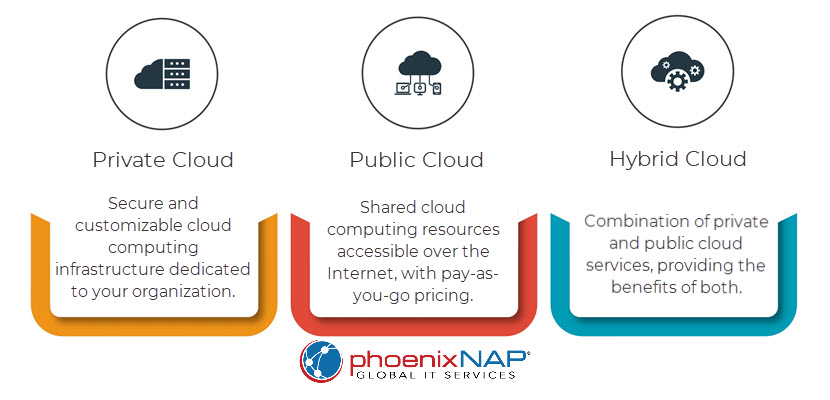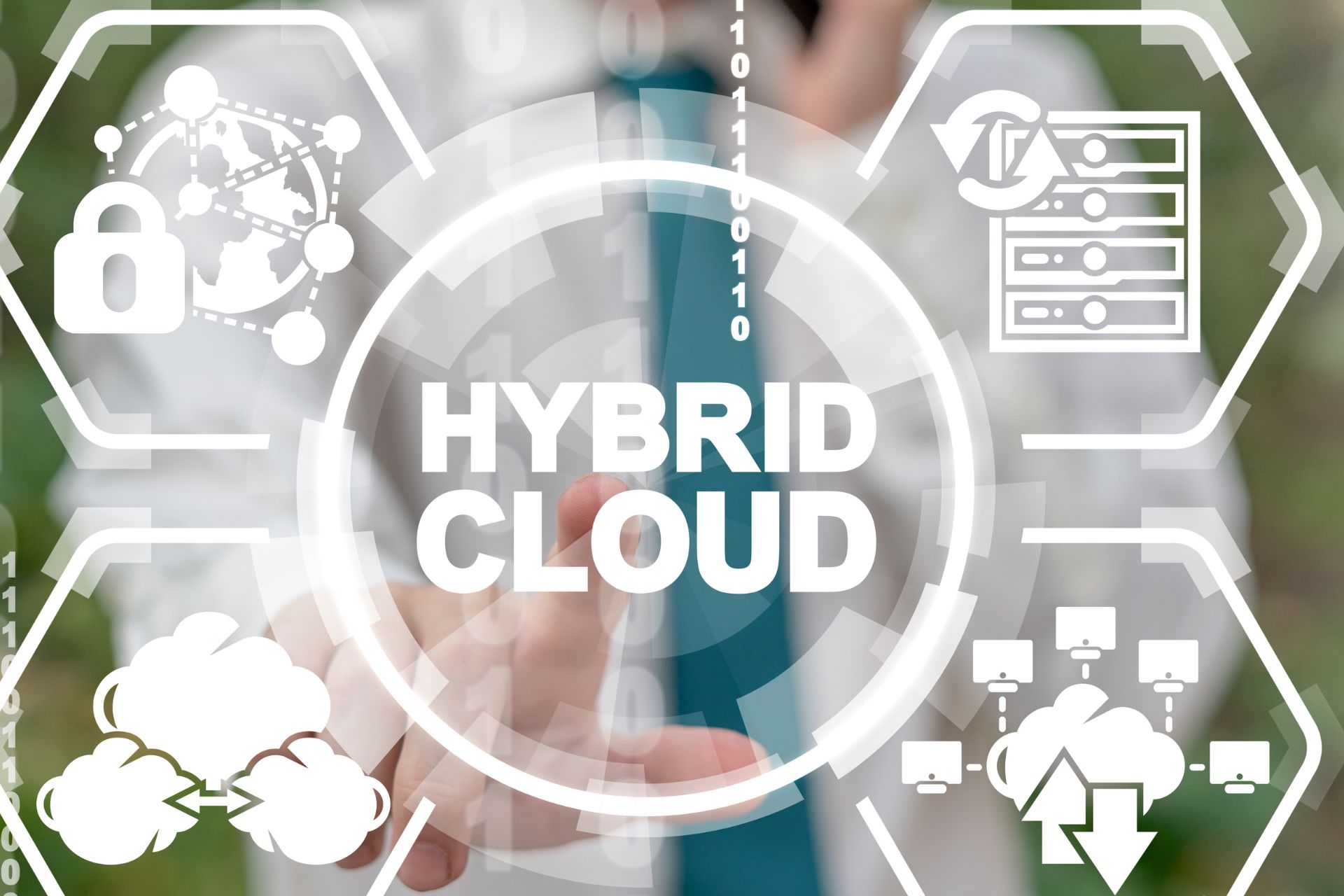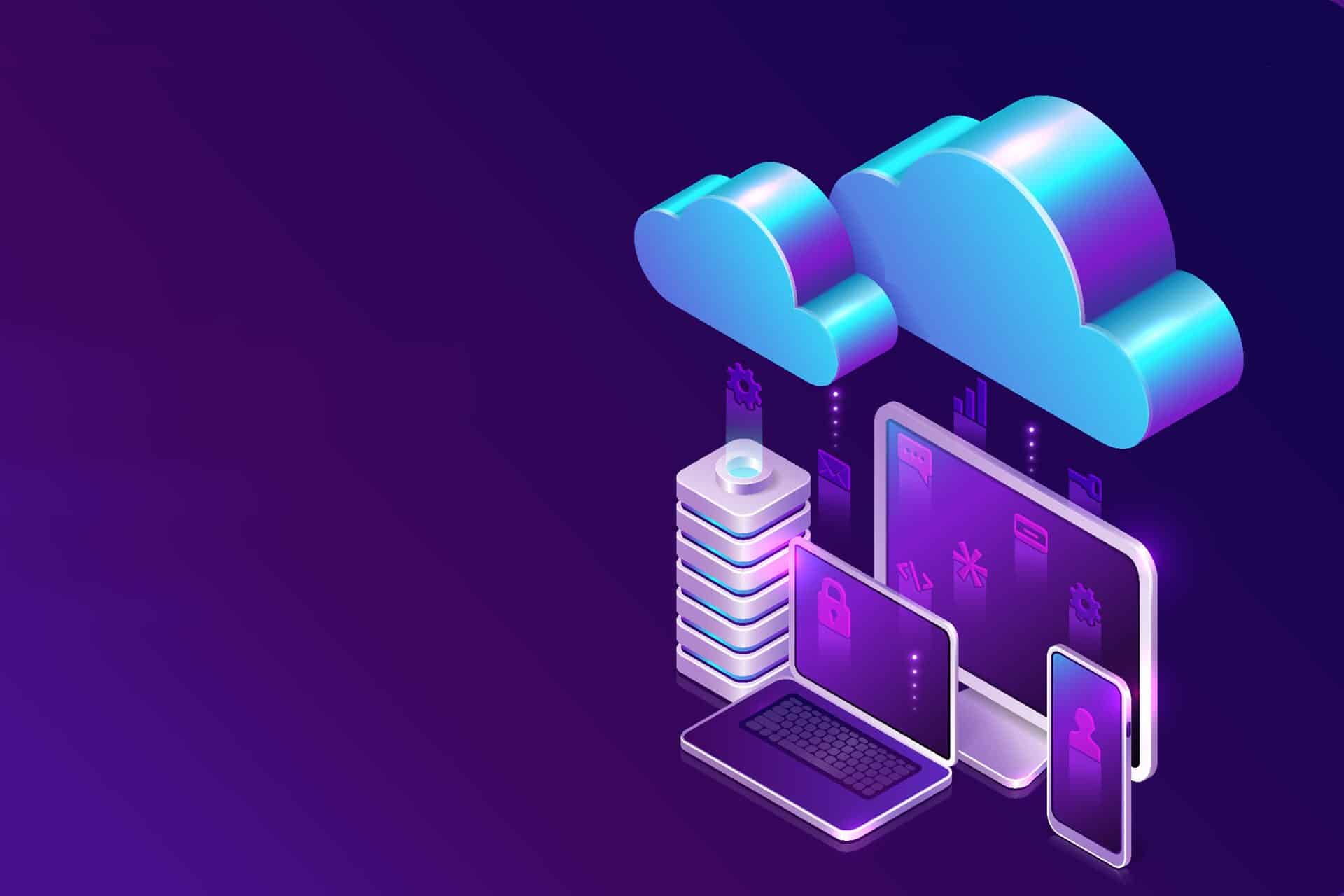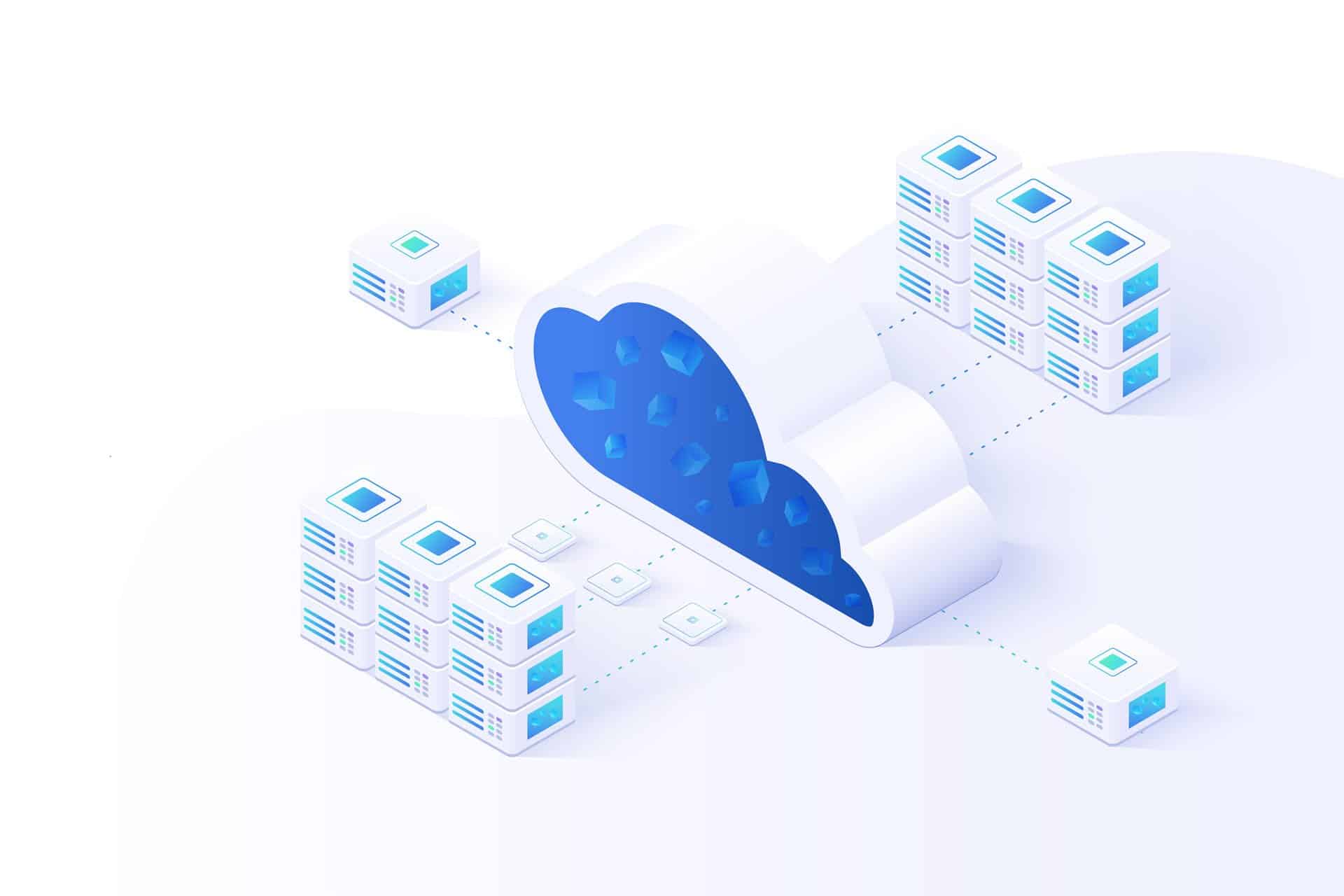A hybrid cloud is a cloud computing environment that combines on-premises infrastructure with private and public cloud services, enabling data and application portability across these environments. It is a cost-effective solution that offers high flexibility, reliability, and performance. However, adopting it comes with several challenges. Most problems arise during the initial setup, so addressing them early is crucial to a smooth transition.
This article examines twelve common challenges of hybrid cloud adoption and provides strategies for overcoming them.

Challenges of Implementing a Hybrid Cloud Strategy
Below is a comprehensive overview of the challenges of implementing a hybrid cloud strategy.
1. Compliance Issues
One of the biggest challenges in a hybrid cloud environment is ensuring compliance with regulatory requirements and industry standards. Different regions and industries have specific laws governing data storage and usage, such as GDPR for personal data in Europe, HIPAA for healthcare information in the US, and PCI DSS for payment card data globally. These laws mandate strict data handling, storage, and processing protocols, which become more complicated when data is spread across multiple environments.
Common indicators of compliance issues include discrepancies in audit logs, frequent regulatory warnings, and difficulties meeting data residency requirements.
Solutions:
- Data residency. Ensure data is stored and processed in locations that comply with regulatory requirements. Use region-specific services and consider data sovereignty laws.
- Audit trails. Implement comprehensive logging and auditing mechanisms to track data access and changes across all environments.
- Encryption. Use strong encryption techniques, such as AES-256, for data at rest and TLS 1.2 or higher for data in transit.
- Access controls. Implement granular access controls using identity and access management (IAM) policies and regularly review permissions to ensure compliance.
phoenixNAP’s Data Security Cloud provides advanced security and compliance features tailored to meet regulatory requirements.
We use region-specific data centers and robust encryption methods to ensure your data is stored and processed in compliance with relevant laws. We also have comprehensive logging, auditing mechanisms, and IAM policies to maintain strict access controls and facilitate easy compliance audits.
2. Lack of Readiness for Data Migration
Migrating data and applications to a hybrid cloud involves complex integration of distinct cloud services and on-premises systems. Each component has unique protocols, data formats, and performance characteristics. Without proper planning, data migration leads to downtime, data loss, and operational disruptions.
Signs of inadequate readiness include frequent data transfer errors, prolonged migration timelines, and incompatibility issues between migrated applications.
Solutions:
- Data mapping. Create detailed data maps to understand dependencies and interactions between data sets across environments.
- Interoperability. Use middleware, such as integration platforms as a service (iPaaS) and APIs, to bridge gaps between different systems and ensure seamless data flow.
- Testing. Conduct thorough testing in a sandbox environment to identify and address potential issues before full-scale migration.
- Optimization. Evaluate and optimize workloads for performance and cost-efficiency in the new environment. Leverage cloud cost management tools for optimization insights.
3. Poorly Defined SLAs
Service level agreements (SLAs) are specialized contracts that define the performance, availability, and security guarantees cloud providers promise to deliver. Poorly defined SLAs lead to misaligned expectations and vulnerabilities, as well as downtime, data unavailability, and security breaches.
Frequent service disruptions, unmet performance expectations, and unclear accountability during incidents indicate a poorly defined SLA.
Solutions:
- Performance metrics. Ensure SLAs include clear performance metrics such as uptime percentages, response times, and throughput.
- Security guarantees. To protect against data breaches, SLAs must define specific security measures and incident response times. They should also include regular security assessments and compliance checks.
- Penalties and remedies. Include penalties for non-compliance and remedies to mitigate potential impacts on the business. These should be clearly articulated in the SLA to ensure accountability.
- Regular reviews. Conduct periodic reviews and renegotiations of SLAs to adapt to changing needs and technological advancements.
4. Skill and Expertise Gaps
Managing a hybrid cloud environment requires diverse skills and expertise, including cloud architecture, cybersecurity, networking, and DevOps. Many organizations lack these capabilities internally and rely heavily on external providers. This lack of in-house expertise often leads to inefficient management, increased operational risks, and missed opportunities for optimization and innovation.
Indicators of skill gaps include cloud service inefficiencies, security vulnerabilities, and increased reliance on external consultants.
Solutions:
- Training programs. Develop comprehensive training programs to upskill existing staff in hybrid cloud technologies and best practices.
- Recruitment. Hire professionals with experience in hybrid cloud environments to fill skill gaps.
- Partnerships. Establish strategic partnerships with cloud providers and third-party consultants to gain access to specialized expertise. Consider hiring managed service providers (MSPs) for ongoing support.
- Knowledge transfer. Implement knowledge transfer processes to ensure continuity and build internal capabilities. Use documentation, workshops, and mentoring programs to facilitate this transfer.
5. Governance Problems
Effective governance is crucial for maintaining control, standardization, and oversight in a hybrid cloud environment. Poor governance leads to fragmented management, increased compliance risks, and difficulties maintaining a cohesive security posture across environments.
Indicators of governance problems include inconsistent policy enforcement and an increase in security incidents.
Solutions:
- Policy frameworks. Develop comprehensive policy frameworks that cover data governance, security, compliance, and operational management.
- Centralized management. Use centralized management tools and platforms to monitor and enforce policies across the hybrid cloud environment.
- Compliance monitoring. Implement continuous compliance monitoring and reporting to ensure adherence to regulatory requirements and internal policies. You can use automated compliance checks and dashboards for real-time insights.
- Role-based access control. Use role-based access control (RBAC) to enforce least privilege and ensure appropriate access to resources. Implement RBAC using IAM policies and tools like Azure RBAC or AWS IAM.
6. Compatibility Issues
Hybrid cloud environments involve multiple infrastructures and technology stacks, which can lead to compatibility issues between tools, platforms, and processes. Incompatibility causes integration problems, operational inefficiencies, and increased costs due to the need for custom solutions and additional management overhead.
Indicators of compatibility issues include frequent integration failures and operational inefficiencies.
Solutions:
- Standardization. Standardize tools, APIs, and protocols across environments to minimize compatibility issues. Use open standards and interoperable technologies wherever possible.
- Middleware solutions. Use middleware to facilitate communication and data exchange between disparate systems.
- Cross-platform tools. Adopt cross-platform tools that can operate seamlessly in both on-premises and cloud environments. Consider tools like Terraform for infrastructure as code (IaC).
- Regular testing. Conduct regular compatibility testing to identify and address issues before they impact operations. Use test automation frameworks to streamline this process.
7. Lack of Visibility and Control
Maintaining visibility and control over a hybrid cloud environment is challenging due to the distributed nature of resources and services. A lack of visibility and control hinders performance monitoring, security management, and compliance efforts, leading to inefficiencies and increased risks.
Indicators of this issue include difficulties in tracking resource usage, detecting security incidents, and maintaining operational oversight.
Solutions:
- Monitoring tools. Implement comprehensive monitoring tools that provide real-time insights into performance, security, and usage across the hybrid environment. Tools like Prometheus and Grafana are instrumental in providing detailed visibility.
- Automation. Use automation frameworks such as Ansible, Puppet, or Chef to manage routine tasks, enforce policies, and maintain consistency across environments.
- Unified dashboards. Use unified dashboards to consolidate monitoring data and provide a single-pane-of-glass view of the entire infrastructure. Solutions like Splunk or ELK Stack aggregate logs and metrics for comprehensive analysis.
- Anomaly detection. Leverage advanced analytics and machine learning to detect and respond to anomalies in real time. Tools like AWS GuardDuty or Azure Security Center use algorithms to identify potential security threats and operational issues.
8. Hybrid Cloud Networking
Networking in a hybrid cloud environment requires careful planning and execution to ensure seamless connectivity, security, and performance. Poor network design leads to latency issues, security vulnerabilities, and connectivity problems, affecting overall performance and reliability.
Indicators of poor design include high latency, frequent connectivity problems, and network security vulnerabilities.
Solutions:
- Network topology. Design a network topology that optimizes connectivity between on-premises and cloud environments, considering factors like bandwidth, latency, and security. Use network design tools and simulations to plan and validate the topology.
- Segmentation. Implement network segmentation to isolate sensitive workloads and enhance security. Use virtual private cloud (VPC) configurations and network security groups (NSGs) to enforce segmentation.
- Traffic management. Use traffic management tools to optimize data flow and reduce latency.
- Direct connectivity. Leverage direct connectivity solutions to establish secure, high-performance links between on-premises and cloud resources.
phoenixNAP operates Arizona’s only Amazon Web Services direct connect edge location. Contact us to improve your network performance and security.
9. Lack of Redundancy
Redundancy is critical for ensuring data availability and business continuity. A lack of redundancy often leads to significant operational disruptions, data loss, and financial losses in the event of system failures or disasters.
Signs of insufficient redundancy include frequent data loss, prolonged system downtimes, and lack of a clear disaster recovery strategy.
Solutions:
- Backup solutions. Implement a robust backup strategy to ensure data is regularly backed up and can be restored quickly in case of failure.
- Redundant architectures. Design redundant architectures with failover mechanisms to ensure continuous availability of critical services. Use multi-region and multi-availability zone deployments to enhance redundancy.
- Regular testing. To ensure the effectiveness of backup and disaster recovery processes, conduct regular testing. Perform failover tests and recovery drills to validate plans and identify areas for improvement.
- Disaster recovery plans. Develop comprehensive disaster recovery plans that outline procedures for restoring operations and data during a major outage.
phoenixNAP offers industry-leading Disaster Recovery as a Service. We combine advanced technology, global infrastructure, and a proven record of delivering robust and reliable disaster recovery solutions.
10. Data Security
Data security is a major concern in hybrid cloud environments, where data constantly moves between on-premises and cloud systems. Protecting data at rest and in transit is essential to prevent breaches and ensure compliance.
Indicators of data security challenges include frequent data breaches, unauthorized data access incidents, and regulatory compliance failures.
Solutions:
- Encryption. Use strong encryption to protect sensitive information.
- Security protocols. Implement robust security protocols and tools to detect and prevent unauthorized access. Use intrusion detection systems (IDS) for real-time threat detection and response.
- Access management. Employ advanced access management solutions to enforce strict access controls and monitor user activities. Use multi-factor authentication (MFA) and identity federation to enhance security.
- Incident response. Develop and regularly update incident response plans to quickly address and mitigate security incidents. Conduct regular security drills and simulations to ensure readiness.
11. Over and Under Provisioning
Efficient allocation of cloud resources is critical to optimizing costs and performance. Over-provisioning leads to wasted resources and increased costs, while under-provisioning impacts performance and user experience.
Indications of server provisioning issues include unexpected spikes in cloud costs, poor application performance, and resource allocation mismatches.
Solutions:
- Orchestration tools. Use orchestration tools to automate and optimize resource allocation, ensuring resources are provisioned based on actual demand. Tools like Kubernetes or Docker Swarm manage containerized workloads efficiently.
- Capacity planning. Conduct thorough capacity planning to anticipate future needs and avoid over or under-provisioning. Use predictive analytics and historical usage data to inform planning decisions.
- Cost management. Implement cost management tools to monitor and control cloud spending. Solutions like AWS Cost Explorer, Azure Cost Management, or Google Cloud's Cost Management tools provide valuable insights and recommendations.
- Scalability. Design systems with scalability in mind, allowing for dynamic adjustment of resources to match workload demands. Use auto-scaling features provided by cloud platforms to automatically adjust capacity based on real-time metrics.
12. Vendor Lock-In
Vendor lock-in is a significant concern when relying on a single cloud provider. Dependence on a single vendor hinders an organization's ability to switch providers or integrate new technologies, leading to higher costs and reduced flexibility.
If switching providers or integrating new technologies is difficult and costly, it indicates vendor lock-in issues.
Solutions:
- Multi-cloud strategy. Implement a multi-cloud strategy to distribute workloads across multiple cloud providers.
- Open standards. Use open standards and interoperable technologies to ensure compatibility and ease of migration between providers.
- Portable solutions. Develop portable applications and workloads using containerization and microservices to facilitate easy movement across cloud environments.
- Regular evaluation. Continuously evaluate cloud providers and solutions to ensure they meet the organization's needs and avoid long-term lock-in.
Migrating mission-critical applications and data to the cloud requires thorough planning to ensure a successful outcome and maximize return on investment.
Our cloud migration checklist provides a roadmap to a smooth, secure, and profitable cloud journey.

How to Manage Hybrid Cloud Challenges?
Here are the steps organizations can take to address hybrid cloud challenges effectively:
Strategy and Planning
A well-defined strategy is crucial for successfully managing a hybrid cloud environment. Begin by outlining clear objectives for adopting a hybrid cloud model. These objectives could be achieving cost savings, increasing agility, or improving disaster recovery capabilities.
Conduct a thorough assessment of your existing infrastructure and applications to determine which workloads are suitable for migration to the cloud and which should remain on-premises. This assessment should consider application dependencies, data sensitivity, and compliance requirements. Finally, establish a cloud adoption roadmap that aligns with your business goals and timelines.
Architecture and Design
Designing an effective hybrid cloud architecture involves ensuring seamless integration between on-premises and cloud environments. Network connectivity is critical; consider using dedicated, secure, and low-latency connections to provide efficient communication between your data center and the cloud.
Implement a robust data management strategy that addresses data migration, integration, and consistency. This procedure may involve establishing data transfer and transformation processes and ensuring data is synchronized and accessible across environments. Furthermore, design your architecture to be scalable and flexible, allowing for easy integration of new technologies and services as needed.
Security and Compliance
Maintaining strong security and compliance is vital in a hybrid cloud environment. Establish consistent security policies across both on-premises and cloud infrastructure, ensuring access control, encryption, and threat detection mechanisms are in place.
Review and update security measures regularly to address emerging threats and vulnerabilities. Additionally, ensure compliance with data governance and regulatory requirements by implementing processes that provide visibility into your cloud environment and maintain audit trails.
Cost Management
Managing costs in a hybrid cloud environment is complex. Implement a strong governance framework that includes budgeting, forecasting, and cost allocation. Regularly monitor spending to identify opportunities for optimization and prevent unexpected costs.
Consider long-term cost savings strategies, such as reserving instances for predictable workloads and implementing automated shutdown schedules for non-production environments. Additionally, establish a continuous cost review and optimization process to ensure your hybrid cloud environment remains cost-effective.
Read our article on IT cost reduction to learn how to reduce costs without resorting to employee layoffs or causing turmoil.
Operations and Management
Efficient operations and management of a hybrid cloud environment require unified monitoring and automation. Implement a centralized monitoring solution that provides visibility across both on-premises and cloud resources, enabling proactive issue detection and resolution.
Automate deployment, scaling, and backup processes to improve efficiency, reduce human error, and ensure consistency across environments. Furthermore, establish a robust incident management process to minimize downtime and quickly resolve any issues.
Governance
Establishing strong governance is essential for effectively managing a hybrid cloud environment. Develop clear policies and procedures for cloud usage, data management, and security. Ensure your team is well-trained and has the necessary skills to manage the hybrid cloud environment.
Review and update your governance framework regularly to adapt to changing business requirements and technological advancements. Additionally, establish a continuous governance and compliance monitoring process to ensure your hybrid cloud environment remains secure and compliant.
Vendor Management
Effective vendor management is crucial in a hybrid cloud environment. Understand your cloud providers SLAs to ensure they meet your requirements for availability, performance, and support.
Be aware of potential vendor lock-in and develop strategies to maintain portability and avoid dependency on a single provider. This may involve implementing multi-cloud deployments or using containerization technologies to ensure workload portability.
Disaster Recovery and Business Continuity
Ensure business continuity by having a well-defined disaster recovery plan. Leverage cloud services to replicate data and applications, enabling quick recovery in case of a failure.
Regularly test your disaster recovery plan to ensure it works as expected and make any necessary adjustments. Also establish a process for updating it.
Continuous Improvement
Hybrid cloud management is a continuous process. Review your hybrid cloud environment regularly to identify areas for optimization and improvement. Stay updated with the latest technological advancements and best practices and be prepared to adapt your strategy and architecture as needed to ensure it continues to meet your objectives. Additionally, establish a process for feedback and learning to drive innovation and improvement in your cloud environment.

Mastering Hybrid Cloud
While the path to hybrid cloud adoption has many challenges, you can effectively manage them with a well-informed strategy. By addressing these challenges head-on, your organization will unlock the full potential of hybrid cloud solutions, achieving greater flexibility, reliability, and performance in your IT infrastructure.



